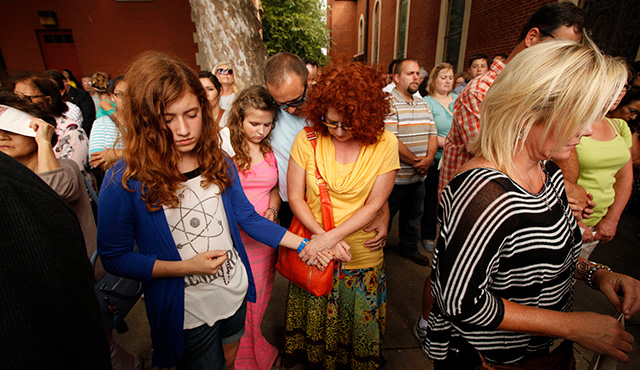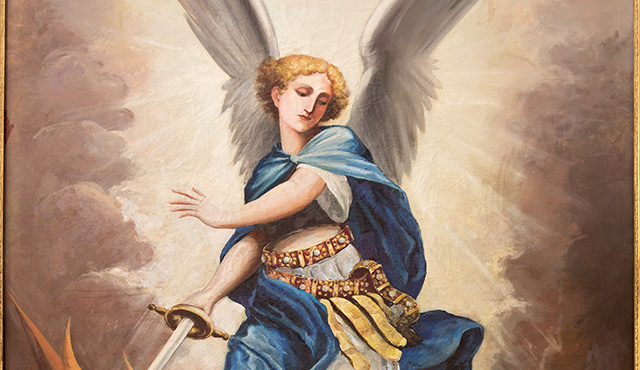By all appearances, Dennis Rader was a good man. A loving husband and a Cub Scout leader, he served as council president of his local Christ Lutheran Church.
But Rader had a secret: Between 1974 and 1991, this upstanding, churchgoing pillar of the community murdered 10 people in Sedgwick County, Kansas. In teasing letters to the local police and news outlets, he described the details of each murder, referring to himself as the BTK Killer; the letters meant “bind,” “torture” and “kill.”
Even the most secular person who hears this story would have a difficult time denying the existence of pure evil. Anyone who simply goes online or picks up a newspaper is subjected to what many claim is irrefutable proof that the devil exists in our world. But is he a real entity or merely a metaphor for the concept of evil?
“The Catholic Church is very clear about this: the devil is real,” says Fr. Christopher Heath, pastor of St. Hedwig Catholic Church, in Los Alamitos. “That’s why we have Catholic teaching, catechism, baptism and rituals against evil.”
The Bible says that the devil can emerge in many forms. He can even manifest himself as an “angel of light,” a deceptive figure who may cloak himself in goodness: a soft-spoken, unassuming Christian living in Kansas, for example.
In Christianity, the devil stands as the most significant opponent of God. Today, many Christians are taught to emphasize the positive – love, grace, charity and hope – to the near exclusion of evil. However, the Catechism of the Catholic Church notes: “Behind the disobedient choice of our first parents lurks a seductive voice, opposed to God, which makes them fall into death out of envy. Scripture and the Church’s Tradition see in this being a fallen angel, called ‘Satan’ or ‘the devil.’”
Contemporary signs of the devil include false doctrine, lust, pride, vanity, arrogance, dishonesty and lack of faith. Another is temptation.
“There are different levels of interaction that evil has with human beings,” says Fr. Chris. “The lowest level, and the most common, is temptation, something that we all have from time to time. This can include wild, random thoughts that come to us without our bidding, and going on the Internet and TV [to websites and programs that should be avoided].”
Fr. Chris recommends “The Screwtape Letters,” by C.S. Lewis. “It’s written from the perspective of evil. The demon talks about how he tempts humans, and by reading it we can learn how some temptations may be very innocuous.”
The other levels of interaction with evil, in ascending order of danger, says Fr. Chris, include, “obsession, oppression and possession. Possessions are the most severe form of demonization. Although they’re rare, they’ve been known to happen. For this reason, Catholicism has a ritual of exorcism.”
Believers and nonbelievers alike frequently ask, how can the devil even exist, at any level, if there’s a loving, all-powerful God? Why would God allow evil in the world?
“God gave angels and humans free will, and by doing that He created the risk that things can go sideways,” Fr. Chris says. “If you don’t have free will, you don’t have love. For example, casting a spell on someone to make him or her love you, [your possession] isn’t really loving you. But with free will, you have the possibility that bad things can happen.
“We can ask, ‘How is it that God is working in a world that has been twisted away from what He wants, and how is He rescuing us?’ That’s the whole story of Christianity: We’ve been fighting to retake the world from a foreign power who thinks he’s ruling the world. If God had created things differently, there wouldn’t be free will, but there would be no love.”
Since God didn’t create us to be bilaterally symmetrical, carbon-based houseplants, we must deal with that ultimate double-edged sword.
“All evil cares about is hurting God,” Fr. Chris says. “If evil can harm us, evil can harm God. That’s the price to pay for free will.”
How, then, can we cope with temptation and, by extension, evil in general?
“First, have a good prayer life,” Fr. Chris says. “When you are more aware of God’s grace and presence in your life, you’re more likely to catch your mind heading toward sin. But if you have a weakness in your life and you let it run wild, you can expect it to lead to something bad. But with a regular prayer life, you can reach out for grace, and you can redirect your thoughts toward something better.
“The other aspect is self-control,” he says. “People don’t want to talk about that as much these days, but it helps to be moderate with what you ‘consume’ and to be careful about who you surround yourself with.”
Although the Dennis Raders of this world are far less than one in a million, we must remember that evil is 100 percent real.


